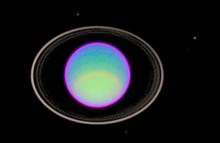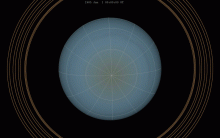Listen to today's episode of StarDate on the web the same day it airs in high-quality streaming audio without any extra ads or announcements. Choose a $8 one-month pass, or listen every day for a year for just $30.
You are here
‘Juicy’ Moons?
Many of the big moons of Jupiter and Saturn appear to have oceans of liquid water below their icy surfaces. And a recent study says that the big moons of Uranus may be “juicy” as well.
The study was led by Julie Castillo-Rogez of NASA’s Jet Propulsion Laboratory. Her team looked at the moons Miranda, Ariel, Umbriel, Titania, and Oberon. Titania is the largest, although it’s less than half the size of our own moon.
The team simulated what’s going on inside the moons. The researchers considered each moon’s size, distance from Uranus, likely composition, and other factors. They also considered an alignment of the moons millions of years ago that could have heated their centers.
The simulations showed that all but Miranda — the smallest of the five — could have oceans. They could range from a few miles deep, to as much as 30 miles for Titania. They could be kept liquid by the internal heat of the moons, or by ammonia or other compounds that lower the freezing point.
A proposed mission to Uranus would scan the moons. Uranus’s magnetic field might cause the oceans to create their own magnetic signatures. The craft’s instruments should be able to detect those signatures — confirming a few more “juicy” moons in the outer solar system.
Uranus is low in the west in the evening twilight. It’s to the upper left of the planet Mercury, which looks like a bright star. Through binoculars, Uranus looks like a faint green star.
Script by Damond Benningfield





